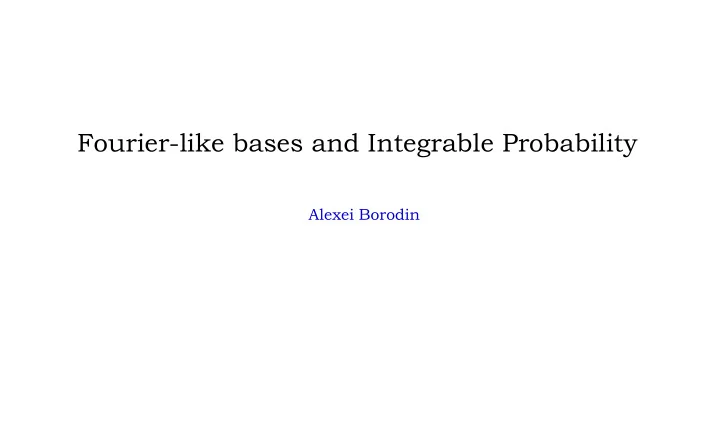

Fourier-like bases and Integrable Probability Alexei Borodin
Over the last two decades, a number of exactly solvable, integrable probabilistic systems have been analyzed (random matrices, random interface growth, lattice models, directed polymers in random media). The solvability of many of them can be traced back to several remarkable Fourier-like multivariate bases. Unraveling the basic structure that underlies the solvability leads to more powerful systems that yield new tractable physical models, new spectral theories, and new phenomena.
Fourier transform on is an orthogonal basis in , and an orthogonal basis in or, equivalently, Direct Fourier transform Inverse Fourier transform Since this basis diagonalizes any linear difference operator with constant coefficients.
Random walk on Inverse Fourier transform Eigenvalue Direct Fourier transform Corollary (Central Limit Theorem)
I would like to argue similar properties of other Fourier-like bases can be used to study 2d random interfaces, as opposed to 1d as in the random walk. Random Plane Partitions Ice-type models Polynuclear growth (directed polymers) However, there is a caveat - our Fourier-like bases will be unusual.
Rational Schur symmetric functions Two orthogonality relations : The Schur functions are characters of the (complex) irreducible representations of (or ).
Rational Schur symmetric functions Branching rule (restriction from to ) Cauchy identity (reproducing kernel) Difference operators Eigenvalues
Random plane partitions Cauchy/MacMahon identity
Random plane partitions Global limit shape (Wulff droplet or 'crystal', Ronkin function of a complex line) Global fluctuations (Gaussian Free Field) Local correlations (translation invariant Gibbs measures) Edge fluctuations (Airy processes)
The Schur symmetric functions (or representation theory of the unitary groups) is a major source of integrable probabilistic systems that include Totally Asymmetric Simple Exclusion Process (TASEP) and its relatives • Last Passage percolation in the plane with special weights • Uniformly random and q-weighted plane partitions with various • boundary conditions (2+1)-Dimensional models of random interface growth • Unitarily invariant models of random matrices •
Spin Hall-Littlewood symmetric rational functions Specializing brings us back to the Schur, while setting yields the Hall-Littlewood polynomials that arise in connection with finite p-groups and representation theory of groups of p-adic type. More generally, one can add parameters and define These functions originate from the six vertex model.
The six vertex model (Pauling, 1935) In 'square ice', which has been seen between graphene sheets, water molecules lock flat in a right-angled formation. The structure is strikingly different from familiar hexagonal ice (right). From <http://www.nature.com/news/graphene‐sandwich‐makes‐ new‐form‐of‐ice‐1.17175> Lieb in 1967 computed the partition function of the square ice on a large torus - an estimate for the residual entropy of real ice.
The higher spin six vertex model [Kulish-Reshetikhin-Sklyanin '81] The Yang-Baxter (star-triangle) equation:
Operators of the Algebraic Bethe Ansatz In define In infinite volume, and need to be normalized: is the length of the strip
Spin Hall-Littlewood symmetric rational functions More generally,
Spin Hall-Littlewood symmetric rational functions Difference operator (transfer-matrix) Cauchy identity �B.'14, B.‐Petrov '16�
Spin Hall-Littlewood symmetric rational functions Orthogonality relations �Tarasov‐Varchenko '97, Povolotsky '13, B.‐Corwin‐Petrov‐Sasamoto '14‐15, B.‐Petrov '16�
The Cauchy identity �B.'14� The partition function normalized by equals Convergence:
Proof - operator approach The Yang-Baxter equation is equivalent to certain quadratic commutation relations between these operators. For example, Assuming , in infinite volume one gets The result now follows from
Proof - pictorial approach
Markovian specialization Set �B. '14, Corwin‐Petrov '15� The resulting random paths in the bottom part of the picture can be constructed recursively via
Markovian specialization �B. '14, Corwin‐Petrov '15� The resulting random paths in the bottom part of the picture can be constructed recursively via with additional sets of parameters
Sampling (the six vertex case) Courtesy of Leo Petrov
q-Moments of the height function �B.‐Petrov '16� For any
The six vertex case - asymptotics �B.‐Corwin‐Gorin '14� Assume Then for where is explicit, is the GUE Tracy ‐ Widom distribution. Gwa‐Spohn �1992�: This is a member of the KPZ universality class. This class was related to TW in late 1990's.
Other models that benefit from s-HL functions Asymmetric Simple Exclusion Process (ASEP) �Tracy‐Widom '08‐09, B.‐Corwin‐Petrov‐Sasamoto '14‐15, B.‐Petrov '16, B.‐Aggarwal '16, Aggarwal '16� Inhomogeneous Exponential Jump Model �B.‐Petrov '17�
Other models that benefit from s-HL functions Directed Polymers in Random Media, KPZ equation, q-versions of TASEP, q-Boson models, Random Walks in Random Environment �Dotsenko '10�, Le Doussal et al. '10, Sasamoto‐Spohn '10�, B.‐Corwin '11�, Povolotsky '13, B.‐Corwin‐Petrov‐Sasamoto '14‐15, Corwin‐Petrov '15, Barraquand‐Corwin '15, B.‐Petrov '16� Quantum non-linear Schroedinger equation (Lieb-Liniger model), quantum Heisenberg ferromagnet (XXZ model) �Babbitt‐Thomas '77, Babbitt‐Gutkin '90, Andrei et al. '12��
Other Fourier-like bases with probabilistic applications Elliptic versions of the s-HL functions (a.k.a. weight functions) Probability: Markovian IRF �Interaction‐Round‐a‐Face� Models, Exclusion Processes with a dynamic parameter �Felder‐Varchenko‐Tarasov '96�, B.'17, Aggarwal '17� (q-) Whittaker functions (eigenfunctions of (q-) Toda lattice) Probability: Directed polymers in random media, q‐deformations of TASEP and of �2�1�‐dimensional interface growth �O'Connell '09�, B.‐Corwin '11, B.‐Corwin‐Ferrari '16� Jack polynomials and Heckman-Opdam hypergeometric functions Probability: General beta random matrix ensembles, log‐gases at arbitrary temperature �Forrester et al. '95�, B.‐Gorin '13, Moll '15, Fyodorov‐Le Doussal '15, Gorin‐Zhang '17�
Summary Fourier-like bases are a key tool in studying integrable probabilistic systems. Their properties are directly linked with probabilistic properties of these systems on one hand, and are deeply rooted in their representation theoretic origins on the other one. Building bridges between the two sides has been very beneficial to both.
Recommend
More recommend